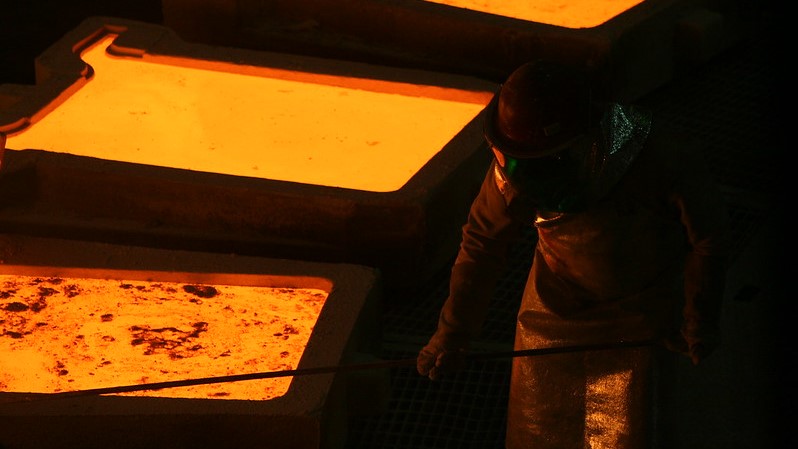
(The opinions expressed here are those of the author, Andy Home, a columnist for Reuters.)
Copper’s long-expected price correction has finally arrived.
London Metal Exchange (LME) three-month metal tumbled by 9% last week and on Monday hit a 10-week low of $9,011 a tonne. It was last trading at $9,230, 14% off May’s record high of $10,747.50.
Bull exuberance has been dowsed temporarily by signals that both the U.S. Federal Reserve and the Chinese authorities are concerned about inflation.
The Fed’s suggestion that it might raise interest rates sooner than expected and Beijing’s announcement that it is preparing to release strategic metal reserves were a double hit to copper’s reflation credentials, compounded by a stronger post-Fed dollar.
But this correction was by no means unexpected, with a sense that the year-long copper rally was running on empty as funds took profits and rotated to other sectors such as resurgent oil.
Money manager long positioning is now much reduced and some funds are even starting to build short positions, which is a sign of just how confused the immediate outlook is for the poster child of the supposed commodities supercycle.
Fund managers have been taking profits on copper’s post-pandemic recovery rally since the first days of May. Outright long positions on the CME contract have fallen by 35% to 65,367 contracts.

The managed money net long position has shrunk to only 20,389 contracts, the smallest collective bet on higher prices since June last year, when copper was trading around $6,000.
It’s worth noting that the latest Commitments of Traders Report covers the state of play as of last Tuesday (June 15), when copper’s mini-meltdown had only just begun.
Given the prevalence of automated momentum-tracking trading on the CME contract, the reduction in long positions may well have accelerated further as copper broke through several chart support areas towards the end of the week.
The exit of fund managers from the copper market has been playing out on both sides of the Atlantic.
LME broker Marex Spectron estimates speculative length on the London market has imploded from a multi-year high of 62% of open interest in February to a current 10% after five straight weeks of reduction.
Analysts at Citi think the collective investor withdrawal from the copper market since February has amounted to 1.4 million tonnes, which goes a long way to explaining the lack of participation at recent price levels.
Citi remains a copper bull for the third quarter, but others are sliding into the bear camp.
Outright fund short positions on the CME copper market have been building quietly over recent weeks and have now reached their highest since May last year at 44,978 contracts.
That tells you not everyone buys the supercycle story.
Indeed, many still believe copper pricing remains beholden to what happens in China, the world’s largest user.
And right now China’s authorities are doing everything they can to push the price of copper and other key commodities lower as they battle rising inflationary pressures.
Slowing import demand from China appears to be feeding through to rising inventories outside of the country
Weeks of increasingly strident threats about high prices culminated in confirmation that the National Food and Strategic Reserves Administration (NFSRA) is planning to release strategic reserves of copper, zinc and aluminum to cool the market.
Given that Chinese state reserves of copper are thought to be at least two million tonnes, this is a powerful price signal that could become a recurring theme in the market narrative.
Beijing may also be pulling less-visible levers with the powerful National Development and Reform Commission (NDRC) “strengthening supervision” of commodity markets, which may or may not be linked to talk of state players in copper cutting positions on international exchanges.
The irony is that Chinese manufacturers probably don’t need any extra copper right now. The country has imported a record-breaking six million tonnes of refined metal since the beginning of last year. The Shanghai Metal Market Yangshan premium – a closely watched indicator of import demand – is languishing at a bombed-out $21 a tonne.
Not only are imports slowing, but exports are rising, to judge by the May trade figures.
It is this dynamic as much as any threatened stockpile releases that has sapped short-term confidence in copper.
Slowing import demand from China appears to be feeding through to rising inventories outside of the country.
LME stocks have rebuilt from a February low of 73,450 tonnes to a current 160,950 tonnes, with time-spreads easing significantly over the interim period. The benchmark cash-to-three-months spread has flipped from $65 a tonne backwardation to a $26 contango, indicating much-improved availability.
For those that think copper remains locked in a China cycle, this is all as expected.
“We think that the slowdown in China will continue in the months ahead, which tallies with our view that the sell-off in industrial metals has further to run,” Capital Economics argues.
Supercycle bulls, naturally, will have none of it.
“The bullish commodity thesis is neither about inflation risks nor Fed forward guidance,” says Goldman Sachs, “it is about scarcity and strong physical demand.”
The bank maintains its view that copper “remains orientated on a path towards clear deficit conditions both over the remainder of this year and into 2022,” whatever the Chinese authorities or the Federal Reserve has to say about inflation.
The problem is that there is no hard evidence yet of that supposed shortage of metal.
It may well be that manufacturing recovery in the rest of the world can pick up the copper demand baton from a slowing China, but it doesn’t appear to be happening just yet.
Copper has hit an indecisive patch and it’s not surprising that funds have gone to play in other markets until Doctor Copper works through the cyclical confusion.
(Editing by David Goodman)
Comments